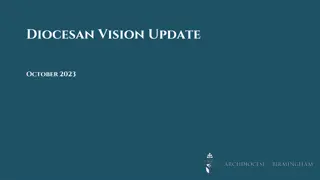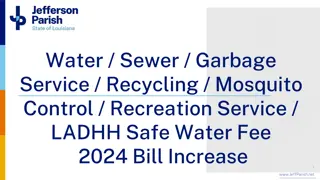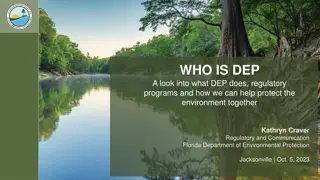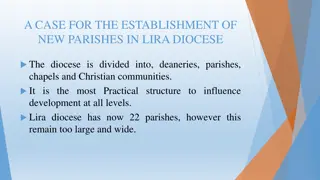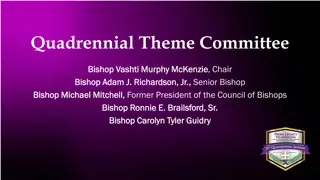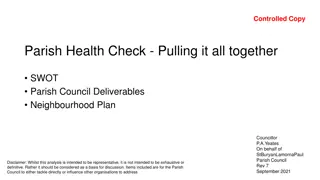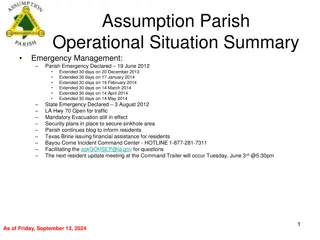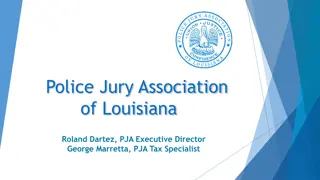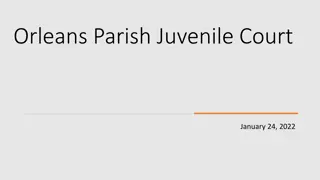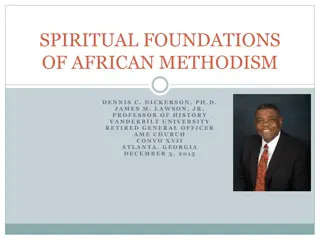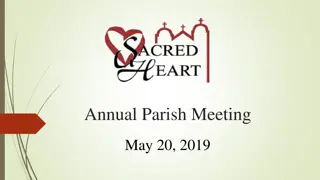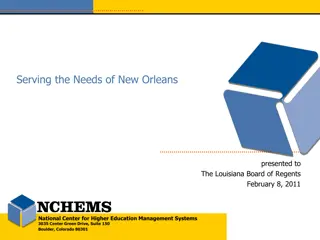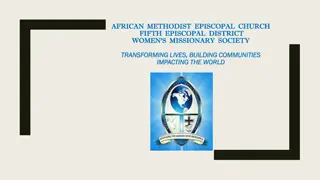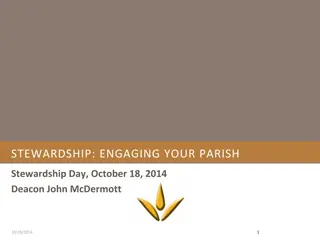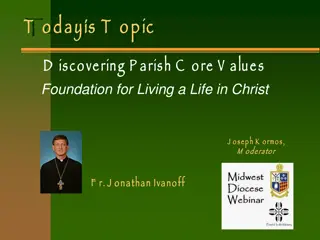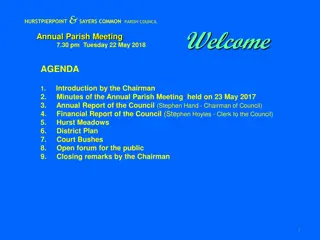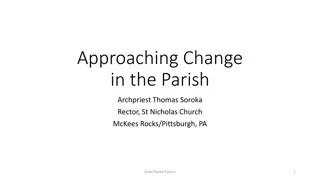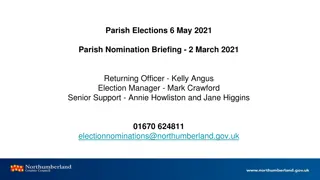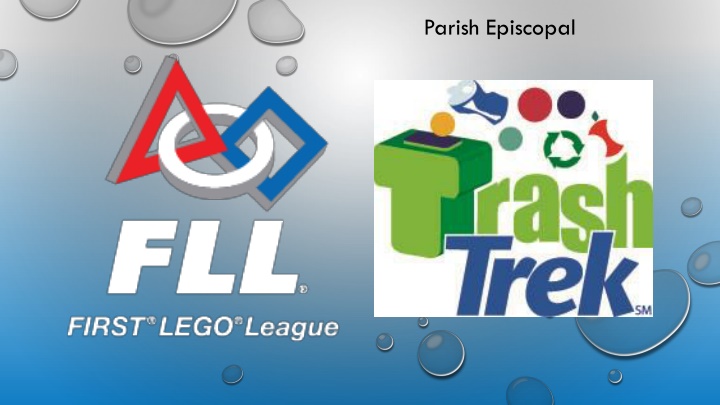
Parish Episcopal Environmental Protection Initiatives
Parish Episcopal discusses the proper management of fats, oils, and grease, emphasizing the importance of not disposing them improperly. The school promotes recycling and conversion of these materials into useful products like biodiesel fuel and renewable energy through anaerobic digestion. Detailed guidelines are provided on solid waste determination and hazardous waste compliance for used oils. The overall focus is on sustainable waste management practices to protect the environment and reduce pollution.
Download Presentation

Please find below an Image/Link to download the presentation.
The content on the website is provided AS IS for your information and personal use only. It may not be sold, licensed, or shared on other websites without obtaining consent from the author. If you encounter any issues during the download, it is possible that the publisher has removed the file from their server.
You are allowed to download the files provided on this website for personal or commercial use, subject to the condition that they are used lawfully. All files are the property of their respective owners.
The content on the website is provided AS IS for your information and personal use only. It may not be sold, licensed, or shared on other websites without obtaining consent from the author.
E N D
Presentation Transcript
Parish Episcopal Environment Environmental Protection Agency (EPA) Resource Conservation Recovery Act (RCRA) Department of Transportation (DOT)
Parish Episcopal Fat, Oil, and Grease Fats, oil, and grease should not be sent to landfills or flushed down the water pipes. Fats, oils, and grease clog pipes and pumps. You can cause sewer overflows. You can harm water quality. You can increase water and restoration bills. Fats, oil and grease should be made into another product. Rendering industry: Fat and solid meat products can be used for animal food, cosmetics, and soap. Biodiesel fuels: Fat, oil, and grease can be used for environmentally friendly biodiesel fuel. Biodiesel is an alternative fuel produced from renewable resources such as soybean oil, canola oil, palm oil, and waste cooking oil. Biodiesel reduces pollution such as greenhouse gases, sulfur dioxide in air emissions, and asthma-causing soot. Biodiesel is simple to use, biodegradable and nontoxic. Anaerobic Digestion: Fat, oil, and grease can be added to anaerobic digesters at wastewater treatment plants to generate renewable energy in the form of biogas.
Parish Episcopal Solid Waste Determination as required by 40 CFR 262.11& 262.40(c) & APC & EC Regulation 23 261.11 1. Waste Common Name Used Oil 2. Description Used Oils- hydraulic oils, lube oils, cutting oils,refrigeration oil, cooking oil, etc. 3. Generating Source Oils generated from maintenance activities, leaking equipment, etc. 4. Physical Form liquid 5. Solid Waste Determination Is this a solid waste? Yes No If yes, continue to Question 6. If no, explain why and skip to Question 8: 6. Hazardous Waste Determination Is this a hazardous waste? Yes If yes, per EPA or state only? EPA If no, because it is: Not listed nor does it display hazardous waste characteristic(s) Insert explanation, including summary of any test results: OR not hazardous waste because it is: Universal Waste Insert explanation:Used Oil meets and is managed under the Used Oil regulations (49 CFR 279 and 279 of Arkansas regs). Oil has TOX<1000 ppm and is not mixed with any hazardous waste. Complete Questions 7a-7e for Hazardous Wastes ONLY All other wastes: Skip to Question 8 7a. EPA/state Hazardous Waste Number(s) applicable waste codes 7b. Listings non-specific source F specific source K discarded commercial chemicalU P comments 7c. Characteristics determined by waste code testing ignitability D001 comments corrosivity D002 comments reactivity D003 comments TC toxic D comments 7d. Land Disposal Restrictions (LDR s) Not applicable restricted waste requires treatment Applicable subcategory: Applicable treatment standard: subject to one-time notice [40 CFR 268.7(a)(7)] Not applicable Applicable subcategory: Applicable treatment standard: subject to one-time notice [40 CFR 268.7(a)(7)] subject to UTS restricted waste requires treatment meets treatment standard UHCs: 7e. Subpart CC Determination/Compliance Applicable and managed in accordance with Subpart CC Exempt: VO < 500ppm by wt. Exempt: managed in containers < 0.1 m3 comments No 8. Onsite Management State only Used oil is collected in metal drums and a totes. For Hazardous Wastes only: Satellite accumulation < 90-day accumulation Used Oil Exempt 9. Final Disposition Offsite reuse Offsite recycle Offsite TSDF Onsite recycling Onsite WWTU / ENU POTW The used oil generated on site is recyled 10. Shipping Information USDOT Shipping Name: Used Oil Hazard Class: n/a UN/NA Number: n/a Packing Group: n/a knowledge RQ: n/a Other - Technical Name: n/a Other - Marine Pollutant: n/a Emergency Response Guide (ERG) Number: n/a Container Designation: n/a Label(s) Required: n/a Mark(s) Required: 11. Overall Comments n/a comments meets treatment standard
Parish Episcopal http://www3.epa.gov/ http://www2.epa.gov/rcra/resource-conservation-and-recovery-act-rcra-training-module-about-used-oil http://www2.epa.gov/hwpermitting/resource-conservation-and-recovery-act-rcra-training-module-about-drip-pads http://www2.epa.gov/sustainable-management-food/industrial-uses-wasted-food#fog http://www.bing.com/images/search?q=Aerobic+Digestion+Process&view=detailv2&id=3195C9235365BBDC771FB C3F773F22F570CBECAE&selectedindex=18&ccid=8lFt2iyK&simid=608045929704916180&thid=OIP.Mf2516dda2c 8a60db7a6a311e9ffe66efH0&mode=overlay&first=1

